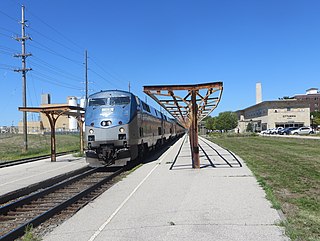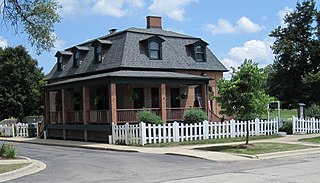
Hinsdale is a village in Cook and DuPage counties in the U.S. state of Illinois. Hinsdale is a western suburb of Chicago. The population was 17,395 at the 2020 census, most of whom lived in DuPage County. The town's ZIP code is 60521. The town has a rolling, wooded topography, with a downtown, and is a 22-minute express train ride to downtown Chicago on Metra's BNSF Railway Line.

The Chicago, Burlington and Quincy Railroad was a railroad that operated in the Midwestern United States. Commonly referred to as the Burlington Route, the Burlington, or as the Q, it operated extensive trackage in the states of Colorado, Illinois, Iowa, Missouri, Nebraska, Wisconsin, Wyoming, and also in Texas through subsidiaries Colorado and Southern Railway, Fort Worth and Denver Railway, and Burlington-Rock Island Railroad. Its primary connections included Chicago, Minneapolis–Saint Paul, St. Louis, Kansas City, and Denver. Because of this extensive trackage in the midwest and mountain states, the railroad used the advertising slogans "Everywhere West", "Way of the Zephyrs", and "The Way West".

Canton station is a historic Chicago, Burlington and Quincy Railroad station located on 4th Avenue in Canton, Illinois. Built in 1914, the station was the second built by the CB&Q in Canton since it began service to the city in the early 1860s. The CB&Q was one of two railroads to serve Canton, along with the Toledo, Peoria & Western Railroad. As the area had few paved roads at the time, the station was the departure point for the city's business travelers, vacationers, and servicemen in World War I and II. Five passenger trains a day, three during daytime and two at night, served the station in its first decade. The station also served freight trains that exported the area's industrial products, which were mainly farming equipment and coal. The popularity of the passenger trains began to decline as roads became better and more popular; as a result, the night trains were cancelled in 1950 and passenger service to the station ended completely in 1961. Freight service also ended in 1980, at which point the railroad had merged into the Burlington Northern; the city bought the station from the railroad in 1989.

Ottumwa station is an Amtrak intercity train station in Ottumwa, Iowa, United States. The station was originally built by the Chicago, Burlington and Quincy Railroad, and has been listed as Burlington Depot by the National Register of Historic Places since November 26, 2008. It became a contributing property in the Historic Railroad District in 2011.

The William L. Gregg House is a historic Victorian building in the Second Empire style located in Westmont, Illinois.

The Batavia Depot Museum is a museum in Batavia, Illinois that was once the town's primary train station. It was the first of many depots built by the Chicago, Burlington and Quincy Railroad. It was listed on the National Register of Historic Places in 1979 as the Chicago, Burlington, and Quincy Railroad Depot.

The Atchison, Topeka and Santa Fe Passenger and Freight Complex is a nationally recognized historic district located in Fort Madison, Iowa, United States. It was listed on the National Register of Historic Places in 1992. At the time of its nomination it contained three resources, all of which are contributing buildings. The buildings were constructed over a 24-year time period, and reflect the styles that were popular when they were built. The facility currently houses a local history museum, and after renovations a portion of it was converted back to a passenger train depot for Amtrak, which opened on December 15, 2021.

Berwyn is one of three stations on Metra's BNSF Line in Berwyn, Illinois. The station is 9.6 miles (15.4 km) from Union Station, the east end of the line. In Metra's zone-based fare system, Berwyn is in zone B. As of 2018, Berwyn is the 79th busiest of Metra's 236 non-downtown stations, with an average of 669 weekday boardings. There is a staffed station building on the south side of the tracks.

Hinsdale is one of three stations on Metra's BNSF Line in Hinsdale, Illinois, and the only one open daily. The station is 16.9 miles (27.2 km) from Union Station, the east end of the line. In Metra's zone-based fare system, Hinsdale is in zone D. As of 2018, Hinsdale is the 35th busiest of Metra's 236 non-downtown stations, with an average of 1,155 weekday boardings. There is a historic staffed station and commercial use building. Originally known as the Brush Hill Train Station, the depot was designed for the Chicago, Burlington and Quincy Railroad by staff architect Walter Theodore Krausch, built by Grace & Hyde Company in 1899, and is listed as a contributing building in the Downtown Hinsdale Historic District.

The William Whitney House, also known as the Hallmark House, is a historic Late Victorian & Italianate residence in Hinsdale, Illinois.

The Downtown Hinsdale Historic District is a set of seventy-three buildings and one park in Hinsdale, Illinois.

The Two Brothers Roundhouse, formerly the Walter Payton Roundhouse, America's Historical Roundhouse, and Chicago, Burlington, & Quincy Roundhouse and Locomotive Shop is a historic building converted to a restaurant in Aurora, Illinois. It was originally constructed in 1856 as a roundhouse for the Chicago & Aurora Railroad and served in this capacity until 1974. It was abandoned until 1995, when a group of investors led by Walter Payton purchased it and converted the building to an entertainment complex. Its most recent tenant is Two Brothers Brewing. The building is the oldest limestone roundhouse in the United States and is listed on the National Register of Historic Places.

The West Side Historic District is a set of ninety-eight buildings on the west side of the Fox River in Aurora, Illinois. Of these, seventy-seven contribute to the historical value of the district.
The Henry C. Middaugh House was a historic residence in Clarendon Hills, Illinois. The Queen Anne residence was built on the north side of the Chicago, Burlington and Quincy Railroad railroad station before Clarendon Hills was even platted. It was added to the National Register of Historic Places in 1978. However, a Catholic church purchased the property in 2002 so that it could expand, and the house was demolished shortly thereafter.

Wyoming was a Chicago, Burlington and Quincy Railroad station in Wyoming, Illinois. Now the headquarters of the Rock Island Trail State Park, the building is listed on the National Register of Historic Places as the Chicago, Burlington & Quincy Railroad Depot. The station has also been restored to the original red color.

Centerville station, now known as the Appanoose County Post 526 VFW Hall, is an historic train station located in Centerville, Iowa, United States. The Chicago, Burlington and Quincy Railroad (CB&Q) bought the Keokuk & Western Railroad in 1903. Centerville served as a dividing point on the line and by 1910 the people in the town started to plan for a larger station. Its architect is unknown, but the depot was probably designed by a CB&Q architect using fairly standard plans that were used by the railroad at the time. Construction of the Prairie School style building began in July 1911 and it was completed in February of the following year. Local contractor B.S. Staley built the building. The building was used by the CB&Q until 1982. It was bought by the Appanoose County VFW post for their meeting hall in 1990 and it was listed on the National Register of Historic Places in 2003 as the CB&Q Passenger Depot.

Keokuk Union Depot is an historic train station on the west bank of the Mississippi River near downtown Keokuk, Iowa, United States. It was built from 1890 to 1891, and it was listed on the National Register of Historic Places in 2013.

Creston station is an Amtrak intercity train station in Creston, Iowa. The station is served by the Chicago–San Francisco Bay Area California Zephyr. Constructed by the Chicago, Burlington and Quincy Railroad (CB&Q) and opened in 1899, the station is listed on the National Register of Historic Places as the Chicago, Burlington and Quincy Railroad-Creston Station. Amtrak moved to the historic station in 2019 from a small station immediately to its east that had been used since 1969. Creston station is also used by the city of Creston as a city hall and community center, known as the Creston Municipal Complex.

The Downtown Aledo Historic District is a national historic district located in downtown Aledo, Illinois. The district includes 75 contributing buildings and a park. The majority of the buildings are commercial structures, but the district also includes the city's Chicago, Burlington and Quincy Railroad station and both the city's and Mercer County's major government buildings. Development in the district began in the 1850s, and the oldest surviving buildings date from the following decade. The district includes examples of many prominent American architectural styles from the mid-19th century onward; the most prevalent styles are Classical Revival, Romanesque Revival, and Italianate.
Walter Theodore Krausch, known as W.T. Krausch (1868–1929), was an American architect, engineer, and inventor who worked for the Chicago, Burlington and Quincy Railroad (CB&Q) from the late 1880s to the 1920s.





















